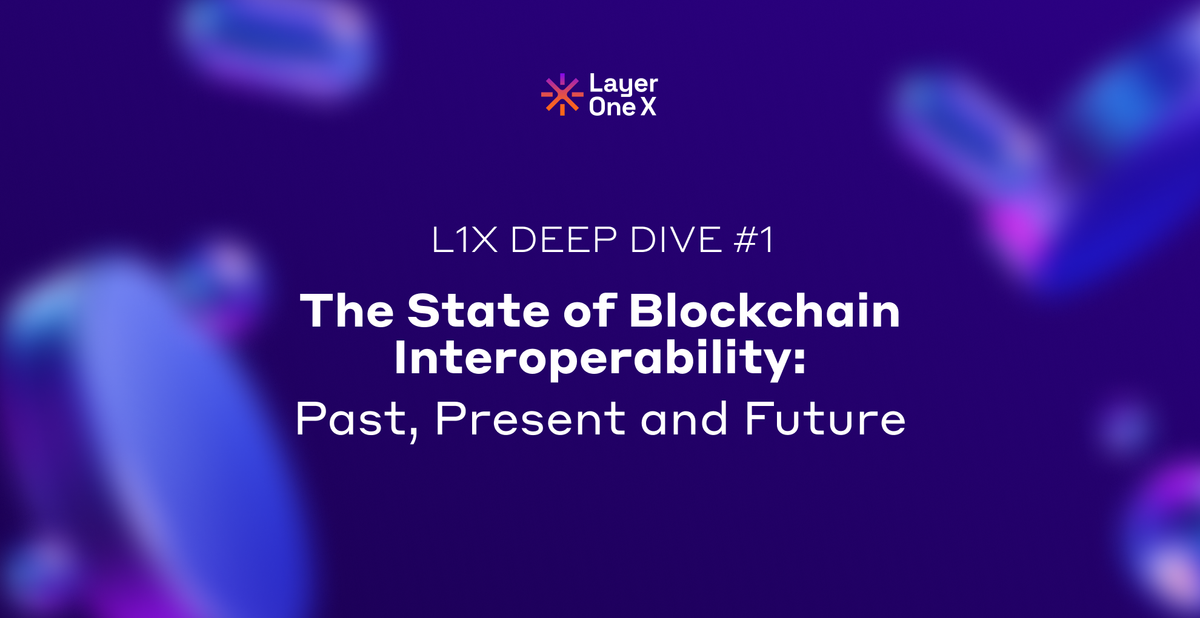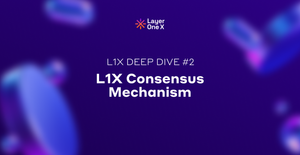Hey there! Ready to dive into the latest buzz from Layer One X (L1X)?
Buckle up because we're about to take you on a wild ride through the latest Layer One X (L1X) AMA held on March 1, 2024.
We set up the stage for an epic deep dive into the world of blockchain interoperability and X-Talk. Join Kevin, the genius behind L1X, and Mohammad, L1X Developer, as they unravel the secrets of smart chain interoperability.
So, grab your favourite snack, get comfy, and join us as we spill all the juicy details about the past, present, and future of blockchain interoperability. Trust us, you won't want to miss a single beat of this epic journey!
WATCH FULL AMA
Section 1 - Introduction to Interoperability and X-Talk: Exploring the Foundations
Kevin discusses the importance of interoperability in the context of L1X and Web3 technology, highlighting the virtual machine's audit by Hashlock. Kevin teases upcoming alpha drops and dive into the infrastructure of X-Talk, comparing it to a smartphone in terms of functionality. Kevin plans to delve into the history of interoperability, explain the flow of X-Talk infrastructure, address security aspects, and provide a non-technical overview of the code.
Section 2 - Evolution of Interoperability: From Bitcoin to Smart Contract Platforms
Discussion about the evolution of interoperability in blockchain technology. In the early phase, interoperability was limited to side chains and issuing assets on the Bitcoin blockchain due to Bitcoin's limitations in throughput, scalability, and usability. This led to the development of phase two, where smart contract platforms like Ethereum introduced Bridges for transferring data between different blockchains. The Bridges accommodate the transfer of tokens between chains based on what, how, and when. However, there were limitations in terms of conditions and determinism. Concepts like Layer Zero networks, such as XLR Network, aim to simplify bridge contracts and integrate oracles for better interoperability. Endpoint templates were introduced to streamline data transfer between blockchains. The focus is on improving the efficiency and flexibility of blockchain interoperability to enhance user adoption and connectivity.
Section 3 - X-Talk: The Smart Chain of Interoperability: Unveiling a New Era
In this part of the video transcript, Kevin discusses the concept of cross-chain technologies and introduces X-Talk as a smartphone or smart chain of interoperability. He explains that X-Talk brings the how, when, and why aspects to the table, in addition to the what, allowing flexibility in moving assets across different chains within an open-source ecosystem. Kevin emphasizes the importance of reducing the number of smart contracts involved in interoperability protocols for success. He also touches on the limitations of moving assets across different chains, highlighting the need for cost-effectiveness, speed, and security. Kevin passes the mic to Mohammad , who then delves into the working of X-Talk, explaining its infrastructure and the flow of data between different networks. The diagram presented shows how the listener module can listen to events emitted by supported low chains, enabling seamless communication between different networks. The decentralized peer-to-peer network allows for intercommunication and data propagation among listeners, ensuring efficient handling of events and data across various chains.
Section 4 - Peer Validation and Transaction Handling: Ensuring Reliability
The video transcript discusses a system where peers validate signatures and elect a leader to handle transactions. The leader is randomly chosen and responsible for sending all signatures to a destination chain. To ensure trust, a piece of code is created for all peers to sign and validate. If the leader fails to fulfill their duties, a new leader is elected. The leader selection process is random and time-based, changing every five minutes or per event. To ensure reliability, a database is implemented in the listener node to store events and serve as a source of truth in case of connection drops. This database helps in not missing any events and ensures seamless transaction fulfillment. The global transaction ID is crucial for scalability and security, allowing for more efficient handling of data.
Section 5 - Global Transaction ID and Seamless Execution: Enhancing Efficiency
They discuss the importance of a Global transaction ID in tracking and fulfilling transactions across different chains or actions. The ID acts as a hash identifier for data, allowing users to easily track and retrieve information related to specific transactions. It can be used for activities like registering a hero in a game or making swaps between different chains. The system is designed to handle multiple transactions under one Global transaction ID, streamlining the process and ensuring all information is accessible. The video also touches on the role of a listener node in handling incoming data, scheduling and storing it, and ensuring it reaches the intended destination. The infrastructure is designed to be agnostic, allowing for seamless execution across different chains without the need for code updates. Additionally, the video mentions the importance of understanding the differences between version 2.1 and version 3 in Layer Zero documentation, emphasizing the need for reliable smart contracts deployment and the ability to scale and update systems efficiently.
Section 6 - Security Measures in X-Talk: Safeguarding Interoperability
Kevin discusses the importance of security in the X-Talk module within the L1X consensus network. He mentions speaking with various projects about interoperability requirements and the common concern for security. The X-Talk score is divided into stake score and event scoring models, with factors like stake balance, stake age, event accuracy, processing time, and integration efficiency being considered. Kevin emphasizes the need to protect information and prevent network breaches, highlighting the ongoing efforts to maintain security within the X-Talk infrastructure. The scoring system rates nodes between zero and one based on various variables, ultimately determining the X-Talk score. Kevin assures that they will not delve into a mathematical lesson but provides a brief overview of how the fuzzy model calculates scores based on different variables.
Section 7 - Scoring System and Node Selection: Ensuring Decentralization
Kevin discussed the scoring system for stake balance and stake age using a fuzzy model to calculate scores between zero and one. He emphasized the importance of collecting data to determine optimal maximum and minimum values. A holistic scoring model is mentioned that takes into account various variables such as uptime, processing time, and reliability in a multi-objective scoring model. The process of joining a node involves checking for minimum stake requirements and being selected as a leader based on X-Talk score and active nodes available. The system ensures decentralization, security, and scalability by allowing nodes to prove their capabilities through hardware and adjusting thresholds collectively. Discussion also included a proposed weightage model for future consideration through governance voting.
Section 8 - Understanding System Structure: Navigating Complexity
Kevin discusses the importance of understanding the structure and process of a system, emphasizing that it involves more than just simple mathematics. He highlights the complexity involved in making the front end and back end of a system work together effectively. The significance of community validation and the technical aspects of a smart contract for cross-chain swaps. The process of saving event data in the smart contract is discussed and the validation steps involved in ensuring the authenticity of transactions. The integration of oracles for fetching conversion rates in a decentralized manner is also touched upon.
Section 9 - Verification and Confirmation Process: Ensuring Security
The video transcript discusses the process of verifying and confirming a swap transaction for euros. The confirmation is associated with a unique ID for the conversion rate, ensuring that the destination amount is valid. The system checks if the destination amount matches the agreed-upon rate, detecting any malicious attempts to alter the amount. Events are stored in the system for verification, ensuring security and decentralization. The payload is built for the transaction, allowing for seamless execution on the destination chain. Interoperability between different chains is achieved through smart contracts, ensuring secure and validated transactions. Overall, the process involves converting and verifying data, checking prices, and executing transactions across different chains.
Section 10 - Transaction Flow and Product Development: Bridging Networks
Kevin discusses the process of sending coins from a listener node back to the L1X core, emphasizing the speed and security of the transaction flow compared to traditional bridges. Kevin explains the decision to stick with the term "Bridges" in their development process, despite initially considering changing it. Kevin then transitions to discussing the concept of interoperability in the open-source world and the development of a product for their client, X-Talk. Kevin highlights the goal of achieving true interoperability across different networks and the ability to manage assets across multiple chains from a decentralized platform. It was noted that there are challenges building applications for different platforms and how X-Talk aims to provide a tool for managing iOS and Android apps simultaneously. Additionally, the complexity and number of contracts required for traditional bridging is compared to the streamlined approach offered by X-Talk on L1X.
Section 11 - Managing Multi-chain Contracts: Simplifying Complexity
In this part of the video transcript, Kevin discusses the complexity of managing different contracts in a multi-chain environment. He explains the process of converting tokens and the risks of integrating fungible and non-fungible token contracts. The importance of a registry contract to track token supplies across multiple networks is emphasized to prevent duplication. The role of the signer contract in issuing and changing tokens is also highlighted. Kevin contrasts this complex approach with Layer Zero's strategy of bundling Oracle, adapter, and relayer contracts into one centralized contract deployed on each chain. This centralized approach reduces the number of contracts and simplifies the process of managing multi-chain assets. Praise was showered upon Layer Zero's documentation and it was stressed that L1X aims to take a similar approach and simplify their documentation for X-Talk and L1X projects, focusing on multi-chain token minting and asset management. L1X stresses on the importance of enabling projects to access liquidity and utilize tokens across multiple chains. There are differences in contract deployment between Layer Zero and L1X, with L1X requiring only the token contract on other chains for multi-chain functionality.
Section 12 - Benefits of X-Talk and L1X: Streamlining Asset Management
Kevin in the video discusses the benefits of using X-Talk and L1X for multi-chain asset issuance and management. X-Talk is highlighted, through which you can reduce the number of contracts needed, such as registry, oracle, relayer, and adapter contracts. The X-Talk registry contract automatically updates when tokens are minted on different chains, providing seamless asset management. The cost of transactions on X-Talk is significantly lower compared to traditional methods. The simplicity and efficiency of using X-Talk and L1X for managing assets across multiple chains is emphasized. Kevin talked about the potential for opening up X-Talk to other protocols in the future but currently focuses on multi-chain asset issuance and management with L1X.
Section 13 - Leveraging Blockchain Adoption: Exploring Use Cases
Kevin discusses the potential of leveraging adoption in the blockchain space, mentioning a use case where stable coins or crypto assets can be used to obtain a credit score on the chain for getting a loan. Kevin expresses excitement about the early stage of interoperability and the technology's ability to solve existing problems. The conversation also touches on hosting nodes, creating token contracts, traditional loans on-chain, third-party node hosting, and upcoming marketing efforts. Kevin emphasizes the importance of simplicity in token creation and the high rewards for hosting nodes to secure the network. Kevin also mentions the ongoing development of documentation and potential collaborations with third parties for loan algorithms and node hosting.
Section 14 - Progress in Web3 Accessibility: Empowering Community
Kevin in the video is discussing the progress being made in the world of web3 and how L1X is making it more understandable and accessible for their community members. L1X is working on providing ongoing learning opportunities for developers and express excitement about discovering new features. Kevin hints at some exciting developments happening behind the scenes from L1X team members. The discussion also touches on hosting nodes and the steps taken and are still being taken to satisfy CEX requirements on nodes, as well as the ability to play games and access rewards on different networks without needing to switch endpoints. Technical requirements for hosting a node are briefly mentioned, as well as the topic of off-chain implementation and the ability to sell usernames connected to data. There is also ongoing work on on-ramp and off-ramp implementation.
Section 15 - TGE Announcement and Community Engagement: Building Momentum
Kevin mentioned that when the market cap hits 10 billion dollars, the team will wear Power Ranger suits and dance in front of the office. Kevin discloses the release date for the TGE (Token Generation Event) on April 2, 2024, expressing confidence in the project's success. L1X encourages community members to be active and excited about the upcoming TGE, emphasizing the importance of community support. Additionally, Kevin mentioned upcoming AMAs and the team's dedication to the project's success. Kevin also jokingly addressed a question about what products are used in their beard, stating that there is no secret and it's just natural.
Section 16 - Acknowledging Team Efforts and Transparency: Fostering Community Connection
Kevin acknowledges the hard work put in by the team, appreciates the community's support, and highlights the importance of transparency in sharing behind-the-scenes work. Kevin mentions upcoming content on Xperts and Node Hosting, as well as consensus or VM infrastructure. The goal is to provide informative videos for the community. Kevin express gratitude for the community's engagement and support, and encourage everyone to stay tuned for more updates.
The AMA session delved into the intricate realm of blockchain interoperability, exploring L1X's innovative X-Talk and developments, while teasing upcoming advancements and discussing the importance of seamless connectivity in the evolving landscape of decentralized technology.
Stay updated on Discord and in our Social Media Channels so you don't miss any important News.
Summaries provided are brief overviews of associated YouTube videos. While we aim for accuracy, they may lack full context. For comprehensive understanding, watch the complete videos.







